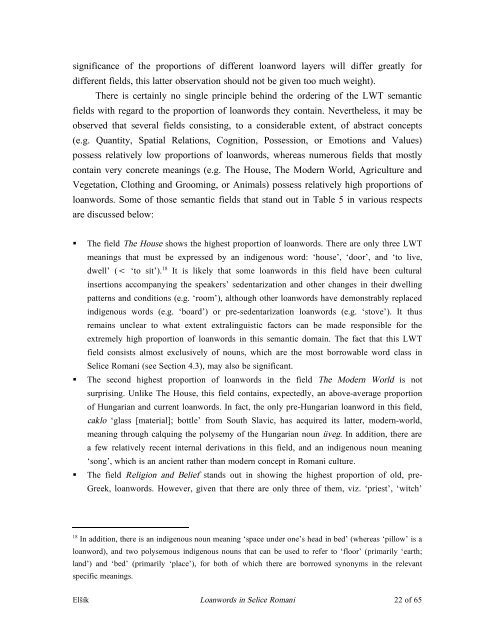Loanwords in Selice Romani, an Indo-Aryan language of Slovakia 1 ...
Loanwords in Selice Romani, an Indo-Aryan language of Slovakia 1 ...
Loanwords in Selice Romani, an Indo-Aryan language of Slovakia 1 ...
You also want an ePaper? Increase the reach of your titles
YUMPU automatically turns print PDFs into web optimized ePapers that Google loves.
signific<strong>an</strong>ce <strong>of</strong> the proportions <strong>of</strong> different lo<strong>an</strong>word layers will differ greatly for<br />
different fields, this latter observation should not be given too much weight).<br />
There is certa<strong>in</strong>ly no s<strong>in</strong>gle pr<strong>in</strong>ciple beh<strong>in</strong>d the order<strong>in</strong>g <strong>of</strong> the LWT sem<strong>an</strong>tic<br />
fields with regard to the proportion <strong>of</strong> lo<strong>an</strong>words they conta<strong>in</strong>. Nevertheless, it may be<br />
observed that several fields consist<strong>in</strong>g, to a considerable extent, <strong>of</strong> abstract concepts<br />
(e.g. Qu<strong>an</strong>tity, Spatial Relations, Cognition, Possession, or Emotions <strong>an</strong>d Values)<br />
possess relatively low proportions <strong>of</strong> lo<strong>an</strong>words, whereas numerous fields that mostly<br />
conta<strong>in</strong> very concrete me<strong>an</strong><strong>in</strong>gs (e.g. The House, The Modern World, Agriculture <strong>an</strong>d<br />
Vegetation, Cloth<strong>in</strong>g <strong>an</strong>d Groom<strong>in</strong>g, or Animals) possess relatively high proportions <strong>of</strong><br />
lo<strong>an</strong>words. Some <strong>of</strong> those sem<strong>an</strong>tic fields that st<strong>an</strong>d out <strong>in</strong> Table 5 <strong>in</strong> various respects<br />
are discussed below:<br />
The field The House shows the highest proportion <strong>of</strong> lo<strong>an</strong>words. There are only three LWT<br />
me<strong>an</strong><strong>in</strong>gs that must be expressed by <strong>an</strong> <strong>in</strong>digenous word: ‘house’, ‘door’, <strong>an</strong>d ‘to live,<br />
dwell’ (< ‘to sit’). 18 It is likely that some lo<strong>an</strong>words <strong>in</strong> this field have been cultural<br />
<strong>in</strong>sertions accomp<strong>an</strong>y<strong>in</strong>g the speakers’ sedentarization <strong>an</strong>d other ch<strong>an</strong>ges <strong>in</strong> their dwell<strong>in</strong>g<br />
patterns <strong>an</strong>d conditions (e.g. ‘room’), although other lo<strong>an</strong>words have demonstrably replaced<br />
<strong>in</strong>digenous words (e.g. ‘board’) or pre-sedentarization lo<strong>an</strong>words (e.g. ‘stove’). It thus<br />
rema<strong>in</strong>s unclear to what extent extral<strong>in</strong>guistic factors c<strong>an</strong> be made responsible for the<br />
extremely high proportion <strong>of</strong> lo<strong>an</strong>words <strong>in</strong> this sem<strong>an</strong>tic doma<strong>in</strong>. The fact that this LWT<br />
field consists almost exclusively <strong>of</strong> nouns, which are the most borrowable word class <strong>in</strong><br />
<strong>Selice</strong> <strong>Rom<strong>an</strong>i</strong> (see Section 4.3), may also be signific<strong>an</strong>t.<br />
The second highest proportion <strong>of</strong> lo<strong>an</strong>words <strong>in</strong> the field The Modern World is not<br />
surpris<strong>in</strong>g. Unlike The House, this field conta<strong>in</strong>s, expectedly, <strong>an</strong> above-average proportion<br />
<strong>of</strong> Hungari<strong>an</strong> <strong>an</strong>d current lo<strong>an</strong>words. In fact, the only pre-Hungari<strong>an</strong> lo<strong>an</strong>word <strong>in</strong> this field,<br />
caklo ‘glass [material]; bottle’ from South Slavic, has acquired its latter, modern-world,<br />
me<strong>an</strong><strong>in</strong>g through calqu<strong>in</strong>g the polysemy <strong>of</strong> the Hungari<strong>an</strong> noun üveg. In addition, there are<br />
a few relatively recent <strong>in</strong>ternal derivations <strong>in</strong> this field, <strong>an</strong>d <strong>an</strong> <strong>in</strong>digenous noun me<strong>an</strong><strong>in</strong>g<br />
‘song’, which is <strong>an</strong> <strong>an</strong>cient rather th<strong>an</strong> modern concept <strong>in</strong> <strong>Rom<strong>an</strong>i</strong> culture.<br />
The field Religion <strong>an</strong>d Belief st<strong>an</strong>ds out <strong>in</strong> show<strong>in</strong>g the highest proportion <strong>of</strong> old, pre-<br />
Greek, lo<strong>an</strong>words. However, given that there are only three <strong>of</strong> them, viz. ‘priest’, ‘witch’<br />
18 In addition, there is <strong>an</strong> <strong>in</strong>digenous noun me<strong>an</strong><strong>in</strong>g ‘space under one’s head <strong>in</strong> bed’ (whereas ‘pillow’ is a<br />
lo<strong>an</strong>word), <strong>an</strong>d two polysemous <strong>in</strong>digenous nouns that c<strong>an</strong> be used to refer to ‘floor’ (primarily ‘earth;<br />
l<strong>an</strong>d’) <strong>an</strong>d ‘bed’ (primarily ‘place’), for both <strong>of</strong> which there are borrowed synonyms <strong>in</strong> the relev<strong>an</strong>t<br />
specific me<strong>an</strong><strong>in</strong>gs.<br />
Elšík <strong>Lo<strong>an</strong>words</strong> <strong>in</strong> <strong>Selice</strong> <strong>Rom<strong>an</strong>i</strong> 22 <strong>of</strong> 65


